To compare various surveillance cameras in 3D drawing software we need a set of constants to begin with. Being from Australia, I am working to the standard AS4806 for the base definitions or resolution criteria. All the examples use here are created using Video CAD Pro but similar results can be obtained with the JVSG IP Video design tool, which is less than $500.
I use the camera installation height of 2.3 metres and a viewing range of 25 metres long by 2 metres scene height, which is typical of a building mounted external camera covering a road way or car park.
My references in the scene are:
- A typical height man located at distances of 1, 2, 3, 4, 5, 10, 15, 20 & 25 metres
- A vehicle parked at 5, 10, 15, 20 & 25 metres
- A Rotakin target at 5, 10, 15, 20 & 25 metres
For each camera, where the lens is integral to the camera, the lens will be tested at its widest and telephoto angles to show the coverage detail at different test object distances.
Where the camera allows you to inter change the lens a 3.6mm and a 12mm will be used as the reference regardless of the imager size and aspect.
The definition of viewing criteria is based on the standard AS4806, which can be obtained from SAI Global.
The starting pixel density is calculated on a typical height person (1.7m) occupying 100% of the screen height. This is referred to as 1ICU or approximately 350 pixels / metre. From this we can define our core criteria’s as follows:
Observe
– Generally observe/monitor behaviour within a broad area
 At this resolution an operator can observe activity in a scene but not be able to determine what a particular person is doing. Typical applications are crowd control for congestion or disturbances in public areas. This type of coverage is of minimal use outside of live monitored systems where an operator can respond to changes in the scene and would often have a PTZ to zoom in to the scene for a more detailed image.
At this resolution an operator can observe activity in a scene but not be able to determine what a particular person is doing. Typical applications are crowd control for congestion or disturbances in public areas. This type of coverage is of minimal use outside of live monitored systems where an operator can respond to changes in the scene and would often have a PTZ to zoom in to the scene for a more detailed image.
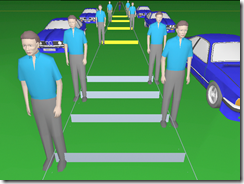 In the image to the right (click to enlarge), we can see at the back centre of the scene a black man at 36 metres from the camera using a 4CIF camera with a 67 degree lens.
In the image to the right (click to enlarge), we can see at the back centre of the scene a black man at 36 metres from the camera using a 4CIF camera with a 67 degree lens.
The minimum person size is 29 pixels tall, which at 4CIF is 5% of the scene. This would be a pixel density of 18 pixels / metre.
Detect
– Detect the presence of a person or object in the scene
 A person can be detected in the scene but not recognised or identified. Typical applications include tracking a persons movement around a scene as an overview, with some detail to distinguish what they are doing. An example would be an isle in a supermarket.
A person can be detected in the scene but not recognised or identified. Typical applications include tracking a persons movement around a scene as an overview, with some detail to distinguish what they are doing. An example would be an isle in a supermarket.
When combined with other cameras for identification, the results can be used to track and convict shop lifters.
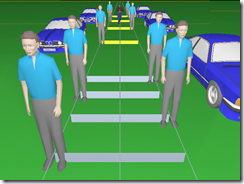 Our scene would look like this, where the black person is able to be detected and tracked from 18 metres away from the camera using a 4CIF camera with a 67 degree lens.
Our scene would look like this, where the black person is able to be detected and tracked from 18 metres away from the camera using a 4CIF camera with a 67 degree lens.
The minimum person size is 58 pixels tall, which at 4CIF is 10% of the scene. This would be a pixel density of 35 pixels / metre.
Recognise
– The ability to recognise a person known to you
 A person in the scene should be able to be recognised if they are already known to you. for example a staff member, regular customer or registered police suspect.
A person in the scene should be able to be recognised if they are already known to you. for example a staff member, regular customer or registered police suspect.
It is common that a surveillance camera will only provide recognition for a portion of the visible scene where the person is close to the camera and the further regions will only provide detect coverage.
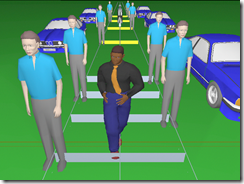 The pixel density required for recognise is greater than 176 pixels / metre (Vert) which is around 44 pixels for the persons head. On a PAL 4CIF signal the person would occupy at least 50% of the scene height.
The pixel density required for recognise is greater than 176 pixels / metre (Vert) which is around 44 pixels for the persons head. On a PAL 4CIF signal the person would occupy at least 50% of the scene height.
Identify
– The ability to identify a person you do not know
 This is the requirement of most CCTV surveillance systems but also the one most often not achieved. In any surveillance system intended to cover a general public area, at least one camera should provide a identification image. ideally this is located at a chock point where the public mast pass such as a entry door, corridor or counter.
This is the requirement of most CCTV surveillance systems but also the one most often not achieved. In any surveillance system intended to cover a general public area, at least one camera should provide a identification image. ideally this is located at a chock point where the public mast pass such as a entry door, corridor or counter.
At a counter it is possible to achieve a good quality identification image and also provide areas of recognise, detect and observe.
The black man to the right is at the maximum this camera could provide ID based on the above settings, using a 4CIF camera with a 67 degree lens. The distance is only 1.1 metres due to the camera angle exceeding 30 degrees.
If I lower the camera by 30cm to 2 metres, I obtain a significantly better result as per the second image.
The pixel density required for identify is greater than 352 pixels / metre (Vert) which is around 88 pixels for the persons head. On a PAL 4CIF signal the person would occupy at least 100% of the scene height.
Number Plates
– The ability to read the characters of a vehicle number plate
 Also referred to NPR or LPR (Number or License Plate Recognition) is where the human eye can read each character. This is different to ANPR, where the recognition is automated via character recognition software.
Also referred to NPR or LPR (Number or License Plate Recognition) is where the human eye can read each character. This is different to ANPR, where the recognition is automated via character recognition software.
Each character needs to occupy 5% of the scene height based on a PAL 4CIF signal. Because each country has different number plate sizes, this is going to vary depending on where you live but based on an average height of 7cm, the total scene height must be less than 1.4 metres
To read the number plate, we need to tighten the lens angle. This image shows a car at 8 metres with a 17 degree angle of view.
This is a pixel density of 410 pixels / metre or for an Australian number plate, or 29 pixels tall for each character. This is also suitable for person identification but often the camera will be pointed too low to cover faces.
Other factors that should ne considered for NPR applications are the amount of reflected light from the number plate at different times of day and nigh as well as shutter speed to accommodate the speed of the vehicle. Typically a camera with a wide dynamic range is required such as the Panasonic Super Dynamic range.
There are many other factors that should be considered when designing the surveillance layout but they need to be taken in to account on a site by site basis. For example if a camera is in a shop with windows to the outside, we need to consider the suns position at different times of the day. Will there be sufficient light at night time?
Related Topics



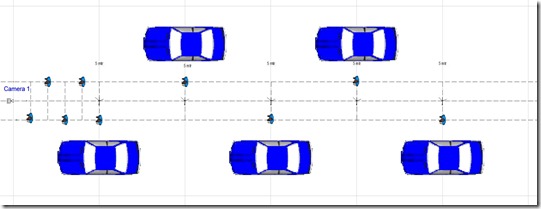


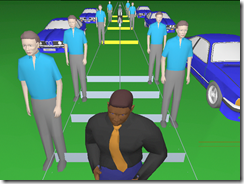
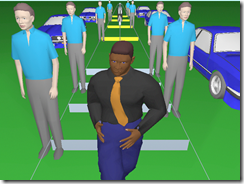
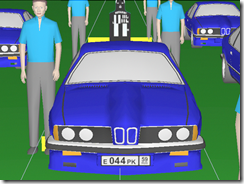
That is really useful information to help people understand what the camera and lens need to be.
Thanks
I would love to have a follow up post on how to work out the qualities using a on line lens calculator
I came here looking at information on how ANPR works after getting a speeding ticket recently and you sure explained it. You obviously know your stuff! Thanks
Surveillance cameras have become an important tool in law enforcement and have enabled us to solve an unprecedented 30% of cases for which video surveillance evidence is recovered.
Surveillance Camera Comparison Parameters are suitable security system is a vital task,After reading this content I have got the best security system. I will use security monitor which will do more helpful for my house an office. It is one of the best allocation about Surveillance Camera Comparison Parameter. Thanks a lot..
Few more things that we should keep in mind before installing
surveillance security system is the size of the data it records should be small. This will ensure low cost for storing a huge amount of the data. A backup for the power must be installed, for the proper working of system in any situation. There are various advantages of installing a good surveillance system despite of its installing cost.
Alica,
Can’t agree more on the back up power (UPS) for a reliable CCTV system.
All DVR’s and NVR’s are just a computer and suffer badly from power fails corrupting the hard drives.
Of course the CCTV system will also need to record during a power fail if the site is serious about security.
I am new and found ur topic good for a newbie . i want to know about how to select different cameras for different locations. this confuses me a lot can u help me on this topic
Hi and sorry for the delayed reply.
The key is to first understand what you want to achieve with the camera.
Do you want to see if there is someone moving in an area or do you want to identify that person from the surveillance camera.
Next look at the environment – Is it indoor or outdoor and if its the latter, do you need to worry about heating the camera from ice or cooling it in the sun.
And the last thing is to consider the lighting environment for both day and night. If you are looking from inside through a doorway or window, you will need a camera with a wide dynamic range. If it is to work in very dark environments, you may need to consider infrared lighting.
I have written articles on each of these topics but the major one you need to look at is detailed in step 1 here – http://cctvdesign.online/tutorials/installation-tips/improving-a-cctv-system-7steps/
I personally use and endorse the IP video Design Tool to calculate the camera/lens requirement to achieve this. http://cctvdesign.online/jvsgv7-preview/#JVSG
Let me know when you have answered these questions and I will take you to the next step.
Good article. Just wanted to add that pixel density is a useful guide, but it’s wrought with problems if its treated as “guaranteed to work” because the ever changing variable is image quality.
Image quality varies between camera brands significantly. I’ve seen a recently installed CCTV system capture an average sized person at 50% of the screen height and even recognizing the person was impossible.
nice.. That is really useful information to help people understand what the camera and lens need to be.
Thanks
regard,
http://www.titikfokuskamera.com